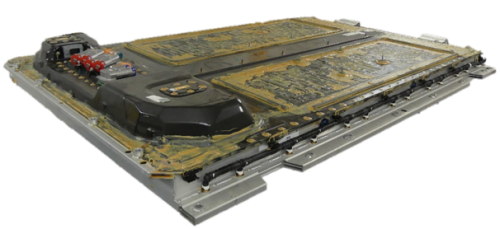In the COOLBat joint research project, researchers from the Fraunhofer Institute for Machine Tools and from Forming Technology IWU have teamed up with partners to develop next-generation battery enclosures for electric vehicles. The objective is to make the enclosures, a central component in any electric vehicle, lighter and cut the carbon dioxide emitted to manufacture them by 15%.
The project partners aim to achieve this by combining individual systems, packing more functions into a smaller installation space, and using new heat-conductive materials and bio-based flame retardant coatings.
Current battery enclosures, with their structures for load distribution and temperature regulation, frames, lids, and base plates, still offer potential for cutting carbon emissions. In the project, 15 partners are conducting interdisciplinary research on innovative lightweight construction principles to reduce mass and on lightweight construction materials and production methods intended to make production of battery system enclosures ecofriendlier and improve their properties in use.
The partners are pursuing a broad-based approach that centers aspects such as circularity and repairability, resource and energy efficiency, safety, and fire protection at the design and material levels.
Fraunhofer IWU in Chemnitz is coordinating the project, which is receiving funding from the German Federal Ministry for Economic Affairs and Climate Action (BMWK) as part of the technology transfer program for lightweight construction (TTP-LB) and is supervised by the Project Management Jülich (PTJ).
The principle is simple: The lighter the enclosures, the greater the range of electric cars, as power consumption decreases.
“The energy density of present-day battery systems has plenty of room for improvement, and battery enclosures are a key aspect there. Integrating new lightweight construction methods and more functions in a smaller installation space with fewer interfaces makes it possible to reduce weight while also cutting carbon emissions.Reducing mass lets us increase energy density, and thus range, even as the number of battery cells stays the same. By making the enclosure lid out of a fiber composite material, we were able to reduce the mass by more than 60 percent compared to the reference out of steel”, says Rico Schmerler, a project manager and scientist in the Battery Systems department at Fraunhofer IWU
Another avenue the researchers have identified for potentially reducing weight is combining individual systems in the enclosure that previously performed thermal and mechanical functions separately. For example, cooling channels cast at the Fraunhofer Institute for Manufacturing Technology and Advanced Materials IFAM are incorporated directly into load-bearing structures such as cross beams.
In addition, the cooling unit function is combined with that of underride protection in a single component, the base plate. Aluminum foam inside the base plate absorbs the impact energy from stone impacts and accidents. Combined with a phase-change material (PCM), a kind of wax that can be used to store and later release a wealth of thermal and cooling energy, the aluminum foam also lowers the amount of energy needed to cool the electric battery. The base plate was developed by Fraunhofer IWU and FES/AES and produced at Fraunhofer IWU, including the foam.
This configuration protects the battery cells from mechanical loads and overheating at once. A fluid flows through the channels, cooling the cells not only from below but also from the sides. This reduces the electricity needed to cool the cells and eliminates the need for cooling elements elsewhere in the vehicle.
“We’re focusing on functionally integrated structures. Tasks that used to be handled by different modules inside the battery are being integrated into a single component—the base assembly, in this case—to shrink the installation space and streamline interfaces. These base plates will provide protection from overheating and avert damage to the battery core in case of an accident”, says Schmerler.




